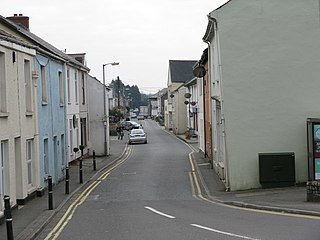This article needs additional citations for verification .(March 2015) (Learn how and when to remove this template message) |
Tresavean is a hamlet in the parish of Lanner, Cornwall, England, United Kingdom.
This article needs additional citations for verification .(March 2015) (Learn how and when to remove this template message) |
Tresavean is a hamlet in the parish of Lanner, Cornwall, England, United Kingdom.
![]()
| This Cornwall location article is a stub. You can help Wikipedia by expanding it. |

Cornwall is a ceremonial county in South West England, bordered to the north and west by the Celtic Sea, to the south by the English Channel, and to the east by Devon, the River Tamar forming the border between them. Cornwall is the westernmost part of the South West Peninsula of the island of Great Britain. The southwesternmost point is Land's End and the southernmost Lizard Point. Cornwall has a population of 568,210 and an area of 3,563 km2 (1,376 sq mi). The county has been administered since 2009 by the unitary authority, Cornwall Council. The ceremonial county of Cornwall also includes the Isles of Scilly, which are administered separately. The administrative centre of Cornwall is Truro, its only city.

Cape Cornwall is a small headland in West Cornwall, UK. It is four miles north of Land's End near the town of St Just. A cape is the point of land where two bodies of water meet. Until the first Ordnance Survey, 200 years ago, Cape Cornwall was believed to be the most westerly point in Cornwall.

Geevor Tin Mine, formerly North Levant Mine is a tin mine in the far west of Cornwall, United Kingdom, between the villages of Pendeen and Trewellard. It was operational between 1911 and 1990 during which time it produced about 50,000 tons of black tin. It is now a museum and heritage centre left as a living history of a working tin mine. The museum is an Anchor Point of ERIH, The European Route of Industrial Heritage. Since 2006, the mine has been part of the UNESCO World Heritage Site Cornwall and West Devon Mining Landscape.

Redruth Station serves the town of Redruth, Cornwall, United Kingdom, and is situated on the Cornish Main Line between Truro and Camborne. The station is 310 miles (500 km) from London Paddington via Bristol Temple Meads.

St Blazey is a small town in Cornwall, England, United Kingdom.

Mining in Cornwall and Devon, in the southwest of England, began in the early Bronze Age, around 2150 BC, and ended with the closure of South Crofty tin mine in Cornwall in 1998. Tin, and later copper, were the most commonly extracted metals. Some tin mining continued long after the mining of other metals had become unprofitable.

Gwennap is a village and civil parish in Cornwall, England, United Kingdom. It is about five miles (8 km) south-east of Redruth.

Lanner is a village and civil parish in west Cornwall, England, United Kingdom. It is situated on the A393 about 2 miles (3.2 km) south-east of Redruth.

Michael Loam was a Cornish engineer who introduced the first man engine into the UK.
The mineral tramways trails are a series of trails located in mid west Cornwall, The trails are as follows:

A man engine is a mechanism of reciprocating ladders and stationary platforms installed in mines to assist the miners' journeys to and from the working levels. It was invented in Germany in the 19th century and was a prominent feature of tin and copper mines in Cornwall until the beginning of the twentieth century.

The Hayle Railway was an early railway in West Cornwall, constructed to convey copper and tin ore from the Redruth and Camborne areas to sea ports at Hayle and Portreath. It was opened in 1837, and carried passengers on its main line from 1843.

Bolenowe is a village in west Cornwall, England, United Kingdom. It is approximately one-and-a-half miles (2 km) southeast of Camborne. It consists of cottages that are spread apart by large gardens, the only amenities are a post box and a red phone box that has now been decommissioned.

John Rogers was an English Anglican priest, mine-owner, botanist, mineralogist, and scholar of Hebrew and Syriac.
Tullimaar House is a mansion just east of Perranarworthal in west Cornwall, England, United Kingdom; it is not visible from the main A39 Falmouth to Truro road, and stands in private grounds. However, the white gate forming the entrance to the property can be seen from the road.

Phoenix United Mine is a disused 19th century copper and tin mine in Cornwall, England, UK. Heavy metals left over in the soil from the mining operations have allowed mosses and lichens to flourish, and today the site is a Site of Special Scientific Interest (SSSI), noted for its biological characteristics.

A gook was a piece of protective headgear worn by bal maidens. The gook was a bonnet which covered the head and projected forward over the face, to protect the wearer's head and face from sunlight and flying debris. Bal maidens often worked outdoors or in very crude surface-level shelters, and the gook also gave protection from extreme weather conditions. By covering the ears, gooks protected the ears from the noisy industrial environment.

Henry Roach was a miner from Cornwall who was Captain of the Burra copper mine in Burra, South Australia for many years. In this position he almost always employed Cornishmen as his assistants, and most of the miners were also immigrants from Cornwall.
Presented below is an alphabetical index of articles related to Cornwall:

The Carnon River is a heavily polluted river in Cornwall, England. It starts in Chacewater. Trewedna Water and River Kennall flow into the Carnon before it merges with Tallack's Creek to become Restronguet Creek, which eventually flows into the English Channel at the mouth of Carrick Roads.